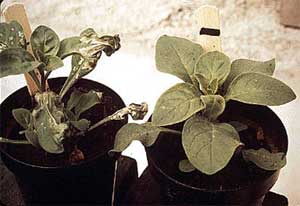Riverside, CAlifornia
July 11, 2005
The harmful effects of smog on
people and animals – the stinging eyes and decreased lung
capacity – are the stuff of well-researched fact. Now, the body
of knowledge about air pollution’s effects on plants has grown
with University of California,
Riverside Biochemistry Professor Daniel Gallie’s discovery
of the importance of vitamin C in helping plants defend
themselves against the ravages of ozone – smog’s particularly
nasty component.
|
 |
|
Ozone-damaged plant (left) and normal plant (right).
Photo courtesy of Gene Daniels/U.S. EPA |
By
manipulating dehydroascorbate reductase (DHAR), a naturally
occurring enzyme that recycles vitamin C, to increase the level
of the vitamin in leaves, Gallie has been able to reduce the
harmful effects of ozone on plants, apparent as brown spots,
stunted size, and lowered crop yields. He and Assistant Research
Biochemist Dr. Zhong Chen published their findings in a recent
paper titled Increasing Tolerance to Ozone by Elevating
Foliar Ascorbic Acid Confers Greater Protection Against Ozone
Than Increasing Avoidance, in the journal “Plant
Physiology.”
Gallie’s previous research found that plants react to smog much
like they react to drought, by closing pores (called stomata)
present in their leaves. The closed pores protect plants from
losing water and taking in ozone, but also prevent the
production of sugars through photosynthesis, which are needed
for the plant to grow.
“It’s clearly not an effective strategy to protect plants from
the effects of long-term exposure to smog,” Gallie said.
Plants, he said, have two options to defend themselves from
ozone. They can prevent ozone from entering the leaf by closing
their stomata, or use the antioxidant qualities of vitamin C to
detoxify the ozone that enters through open stomata and also
protect the photosynthetic machinery in the leaf.
Studying acute and chronic ozone exposures, Gallie and Chen
looked at which plants fared better, those with lower levels of
vitamin C that closed their pores or those with higher levels of
vitamin C, open pores, and higher levels of photosynthetic
activity. Those with the higher levels of vitamin C fared better
in the long run, in both instances, despite the fact that more
ozone entered through the open pores of the leaf, Gallie said.
Gallie and Chen’s findings offer a clear direction for a
strategy toward developing plants that will be able to grow and
thrive in high-ozone environments such as cities and suburban
areas.
“Because we’re seeing, especially in this country, the
encroachment of urban areas into farm lands, we’re seeing an
increased impact on agriculture. Moreover, ornamental plants
used for urban and suburban landscaping are heavily affected by
exposure to smog,” said Gallie.
The next step in Gallie’s research will focus on the apparent
correlation between a plant’s increased vitamin C levels and
increased photosynthetic activity.
“There seems to be multiple benefits of increasing the level of
vitamin C in plants, including improving their tolerance to
smog, improving photosynthesis, and improving their nutritional
quality but more research is clearly needed,” he said.
The key question, at least in the near term, is to determine
whether increased vitamin C and photosynthesis will result in
greater crop yields, he added.
Related
Links:
-
Plant Physiology journal
-
Daniel Gallie's faculty Web
page
The
University of California, Riverside is a major research
institution and a national center for the humanities. Key areas
of research include nanotechnology, genomics, environmental
studies, digital arts and sustainable growth and development.
With a current undergraduate and graduate enrollment of nearly
17,000, the campus is projected to grow to 21,000 students by
2010. Located in the heart of inland Southern California, the
nearly 1,200-acre, park-like campus is at the center of the
region's economic development. |